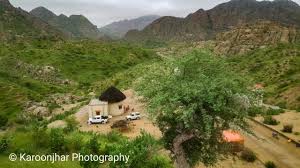The road to achieving full heritage status for the Karoonjhar mountains has been fraught with challenges. Initially, only 16% of the range was granted heritage designation, leading to widespread discontent among local residents and environmentalists. This limited acknowledgment raised fears that vital ecological and cultural areas would remain vulnerable to exploitation, particularly through mining and other extractive practices.
On September 14, the Sindh Cabinet announced a limited protection for 21,000 acres, but this fragmented approach was met with resistance. Community members argued that a piecemeal designation undermines the mountains’ significance as a holistic ecosystem and cultural landmark. The legal battle intensified when Advocate Shankar Lal filed a contempt petition, compelling the court to reconsider the adequacy of the initial designation.
Significance of the Karoonjhar Mountains
For the residents of Nangarparkar, the Karoonjhar mountains are not just geological features; they are an intrinsic part of their identity. These mountains hold deep spiritual value, often appearing in local myths and cultural narratives. The ruling to protect the entire range acknowledges this profound connection between the land and its people.
By recognizing the Karoonjhar mountain as a protected heritage site, the court has validated the cultural narratives that have shaped local identity. The ruling ensures that future generations will continue to engage with their cultural heritage, preserving the stories, traditions, and spiritual practices associated with these sacred lands.
Legal Protections and Community Rights
The legal ramifications of this ruling are profound. The Sindh High Court’s decision includes a stern warning: any violation of this order will be treated seriously under Article 204 of the Constitution. This legal framework establishes a robust mandate for protecting the Karoonjhar mountain range, ensuring that the community’s rights and interests are upheld.
Moreover, the ruling provides a template for other regions facing similar threats. It illustrates how legal channels can be effectively employed to advocate for cultural and environmental protections. Communities can take inspiration from this case, encouraging them to engage in advocacy to safeguard their own heritage.
Collective Action and Advocacy
The successful mobilization of community members played a pivotal role in achieving this ruling. Residents, environmentalists, and cultural advocates united in their efforts to demand comprehensive protection for the Karoonjhar mountains. Their collective action underscores the vital role of grassroots movements in shaping policy and preserving cultural heritage.
Through protests, community gatherings, and awareness campaigns, the local population voiced their concerns and emphasized the importance of these mountains to their identity. This grassroots activism not only influenced the court’s decision but also showcased the need for ongoing collaboration between communities and government authorities.
Environmental and Cultural Intersections
As we reflect on this ruling, it is essential to consider the intersections of cultural and environmental sustainability. Protecting the Karoonjhar mountain sets a vital precedent for other regions grappling with similar challenges. This case serves as a reminder that the conservation of natural landscapes is crucial for maintaining cultural identity.
By safeguarding the ecological integrity of the Karoonjhar mountain, the court has acknowledged that cultural heritage is inextricably linked to environmental health. Communities around the world can draw inspiration from this ruling, advocating for the protection of their cultural and natural resources.
Conclusion
In summary, the declaration of the Karoonjhar mountains range as a protected heritage site marks a critical victory for cultural preservation and community empowerment. This ruling not only affirms the sacredness of the mountains to the local population but also emphasizes the need for comprehensive protection of culturally significant areas.
The commitment of the Sindh High Court to uphold this ruling sets a powerful precedent for future initiatives aimed at protecting cultural and natural heritage. It serves as a reminder that collective action and advocacy can lead to meaningful change, ensuring that future generations inherit a world that respects and honors their cultural values.
As we celebrate this victory, let it inspire communities everywhere to take action in defense of their cultural and natural heritage, protecting it for generations to come. The Karoonjhar mountain stand as a testament to the resilience of local communities and the importance of preserving our shared heritage.





